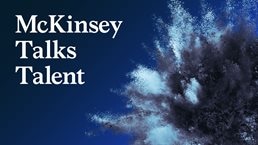Welcome to McKinsey Talks Talent, a new podcast featuring McKinsey leaders and talent experts Bryan Hancock and Bill Schaninger. In this second episode, Bryan and Bill speak with McKinsey Publishing’s Lucia Rahilly about novel ways to spur sales performance, as well as HR’s untapped opportunity to link talent to value in discussions with the CEO. This is an edited version of their conversation.
For more from Bill and Bryan in the future, subscribe to the McKinsey Talks Talent podcast on Apple Podcasts, Google Podcasts, or the audio player of your choice.
Selecting for star talent
Lucia Rahilly: Last time on McKinsey Talks Talent, we talked about the financial risks of neglecting your people strategy. Today, we’ll explore how taking a data-driven approach to managing talent in your sales force can step up top-line growth. Bryan, translate that for us.
Bryan Hancock: What you’re saying is, HR can help sales make more money. And that’s something every salesperson likes to hear. There’s a reason for Alec Baldwin’s famous line, “Put that coffee down. Coffee’s for closers only.” Because you can know analytically what a closer is. There are lots of levers to improve sales—your coverage model, the selling proposition, the pricing. But when other elements are constant, the better salesperson closes the deal.
It comes down to the people. And who unlocks the people? HR. This is one of the few times HR gets to say to the CEO and the head of sales, “I can help you make more money.” The results are real, and they’re not hard to achieve if you apply analytics to the problem.
Lucia Rahilly: How does the notion of employee lifetime value relate to customer lifetime value?
Bill Schaninger: It’s remarkable how we apply rigor to understanding customers but not employees. Our social-media platforms can predict when we’re going to have an affair or what product we might want to buy, but we can’t predict what will have the most impact on our employees. That’s unacceptable.
Lucia Rahilly: What kind of data tells you a performer will be star talent over the course of a lifetime?
Bryan Hancock: The data varies and comes from lots of different sources. Take work we did with a fast-food chain. At the start, its leadership said, “We think our burgers, chicken, and fries are about as good as everybody else’s. We want to look at the people.” That requires a broad understanding of who your employees are, not just a pencil-and-paper assessment.
We asked employees to wear smart badges, which tracked how much listening and talking they did and when they were talking to coworkers, managers, or customers. We analyzed a lot of different data—tenure, education level—and conducted a robust segmentation of the workforce. And we discovered the segments expected to drive the most sales were exactly the ones that weren’t.
—Bryan Hancock
Lucia Rahilly: Can you give an example?
Bill Schaninger: The restaurant built its whole system around speed of service—all its KPIs [key performance indicators], everything it tracked. And not only was this not correlated to repeat sales, it might have even had a slight negative effect on customer satisfaction. Once people come inside, they’re beyond the 30-second pit stop. They’d really like their order to be correct and taste good. But with a model based on speed, all the cues the restaurant was giving employees were wrong.
The first step was to get clear on what customers wanted and how that translated into whether the restaurant made money, and then get into debunking myths about which kind of employees to hire. At the front counter, for example, everyone wanted a personable employee. But in practice, that person spends too much time talking—and when you’re talking, you’re not paying attention to getting the order exactly right.
Lucia Rahilly: Getting an order right seems like the sine qua non of any kind of customer service.
Bill Schaninger: You’d think. But situations very quickly become about the distraction in front of you versus what matters. In a cacophony of noises and messages, employees need to be able to lock in on procedure. Some people really like routine—they’re perfect for this setup. Natural entrepreneurs are terrible for it; they want to try to do something different, whereas this whole model is built on turning the crank.
And that’s just selection. Then there’s matching up who employees are and where they’ve done better or changing the basics of customers’ experiences. Suppose you load up two- and three-star employees on Friday night but leave Sunday and Tuesday afternoons uncovered. When do complaints come in? Sunday and Tuesday afternoons. Those customers don’t care when the problem happened—they’re not coming back.
The human-dynamics and talent challenges come down to this: pick the people you need based on data. Deploy them in a way that makes sense for your business model. And then reward them for the things they need to do, like for getting the order right—not for being really fast but getting it wrong.
Subscribe to the McKinsey Talks Talent podcast
Bryan Hancock: At the fast-food restaurant, we ended up with four archetypes. First, the social person, who gets distracted. Next, the entrepreneur, who’s always thinking, “Hey, is there a better way for me to make this?” In an interview, the entrepreneur sounds great, but there’s a reason we have standard operating procedures. Then there’s the managerial track. But the person who doesn’t get easily distracted, wants to do a good job, and only talks to customers and managers is super focused. That person isn’t social, or entrepreneurial, or a future leader. That person is a really good frontline worker.
Frontline workers were least likely to be selected before, and we started selecting for them at an 80 percent rate—a radical shift. Same-store sales went up 5 percent. In a retail or restaurant job, people drive the experience, so just getting assessment right rings the register.
Raising performance at every stage
Lucia Rahilly: Performance in sales is so quantifiable, but now we’re talking about assessing the value of employees over the course of a career. How does that work?
Bryan Hancock: Improving sales through people, improving revenue through people: at the front end, they’re about selection. Are we getting the right people in the door? Next you need to think about that salesperson, that revenue generator, over the course of a lifetime.
Take that critical first six months. The difference between a newcomer and a longtime performer is huge. And many sales organizations churn through the frontline sales force. Getting newcomers up to speed faster drives impact. Some of this is good, old-fashioned early-stage sales management. And some is applying new tools and techniques and thinking about who your revenue generators are—a cashier at a fast-food restaurant, a call-center worker, a traditional insurance sales force. They all have different flavors, but what they have in common is a ramp-up period. We should be very intentional about shortening time to impact, using science and new techniques.
Bill Schaninger: Most of the time, doing an exercise like “spans and layers,” you assume all the people beneath the leader are fully trained. They’re not, but you can cut their ramp-up period by giving them just-in-time training, real-time coaching, behavioral cues—not nags, but nudges about what they should be doing. And you need a broader system—the weekly standard work for leaders and employees’ own daily standard work—that increases the likelihood of impact.
—Bill Schaninger
Lucia Rahilly: How does this approach affect attrition?
Bryan Hancock: That depends. In some sales organizations, attrition negatively hits the bottom line; what matters is the number of feet on the street. Underperformers get weeded out, but doing more to make more salespeople more successful—and to keep them in role—translates into more money.
Then the question becomes, how do you slow attrition? Take staffing companies, where turnover directly hits the bottom line. Staffing companies get paid when they put people to work. If an employee stops working, the money stops. Algorithms bring science to why someone might quit an assignment—pay, distance, working conditions—and help you match to the right assignment an employee likelier to stay longer. And when you understand the likelihood of turnover, particularly in early months, you can work against it. We’re seeing analytics used in a variety of sales-force contexts where stopping attrition really affects the bottom line.
Lucia Rahilly: What’s an example of science that helps you anticipate attrition?
Bryan Hancock: Data amplifies everything, for good and bad. Data can absolutely be used for good here by highlighting when you need an intervention. We recently had a great internal meeting where everybody wore sociometric badges—badges that record when you’re in proximity to certain folks, plus who’s talking versus listening. Suppose we saw that at Bill’s table, Bill talked 90 percent of the time. We could ask Bill whether he intended to talk so much and use data to inform coaching on what the balance of interactions should be.
Lucia Rahilly: So it’s a developmental tool, not a tool that’s designed for judging?
Bill Schaninger: I wouldn’t make it evaluative. It helps get to why a person is behaving a certain way. Do you feel like you need to show up like a leader? Like you need to have all the answers? Are you behaving with intention? If yes, do you realize you weren’t just talking a lot—you actually talked over three people? It helps us work on behavior.
Take an area where frontline workers know more than leadership. If you’re a leader, you’ve got to learn to connect and draw out that knowledge. In our context, good project managers acknowledge when junior staff know more than they do and bring them into problem solving. Bad ones just issue work assignments, and then their team hates the place. This isn’t about creating “Kumbaya” and “Thunderdome” moments; it’s about creating environments that inspire people to do better work. When they’re doing better work and they’re engaged, they enjoy it more, and they don’t leave.
Would you like to learn more about our People & Organizational Performance Practice?
Lucia Rahilly: But the term “lifetime value” seems inherently evaluative, right?
Bryan Hancock: There are two different concepts here. One is the lifetime value of a customer: there are proven ways to figure that out from day one. The lifetime value of an employee is geared toward improving performance. That might be in onboarding, or training, or when people reach development plateaus, identifying in targeted ways where their gaps lie—in their coaching, or how they’re building out their sales teams, or how they’re collaborating, or how they’re working on more complex sales, which require a new skill set. If you assess the value an employee contributes over time, you can try to raise it at every single point. And most interesting, in the sales context, you can tie it to revenue or to a proxy.
That’s where it gets exciting for HR. HR has too often been in a world of budget cuts. And for it to turn the tables and say, “Hey, I can drop an extra $10 million to the bottom line with a $1 million investment in this set of tools”—trust me, that’s incredible.
It also enables a second conversation many more HR leaders should have about parts of the business that are harder to measure but matter equally to long-term health. If I were CHRO [chief HR officer], I would review all the revenue generators, the assessments, how we onboard, and how we train and say, “On this basis, I think there’s $50 million in incremental money to the bottom line. If I capture that, I’ll contribute two-thirds, and I want one-third back to invest in the other functions.” If more HR leaders used revenue to prove the value case, we would have many more people on this end of the spectrum.
Bill Schaninger: If a sale is the test question, what’s the precursor to that? What’s the critical thing you need to excel at to succeed in these roles? Gear for that, select for it, reward for it, and pull it through. And for life-cycle roles, from prospecting to closing, you’ll have a longer run. A lot of this is just job definition: What’s the role?

McKinsey Talks Talent Podcast
Bryan Hancock, Brooke Weddle, and other talent experts help you navigate a fast-changing landscape and prepare for the future of work by making talent a competitive advantage.
Attracting top talent in tight markets
Bryan Hancock: One area CHROs and CEOs shouldn’t forget is where talent limits growth—in onshore drilling, for example. An oil company can have all the equipment it needs, plus more than enough demand. But it might not have the drillers necessary to drive higher revenue. And in a competitive market, people who operate drilling equipment can pick where they go.
We helped a company analyze talent during the last oil boom. We ended up doing surveys—visiting local bars, asking about perceptions of drilling companies on various metrics, figuring out what mattered most. The hypothesis was pay. But as it turned out, companies just had to be in the ballpark on pay. Same with some other factors—shifts, food in the camp. What mattered most was the perception of safety. And in fact, this company was as safe as, if not safer than, its competitors. But its competitors had branded safety more effectively.
Bill Schaninger: In commodity businesses, talent can be feast or famine. In capital-productivity work, you can run out of welders, run out of pipefitters. They tend to follow big projects. You need to compete for them.
In a market where employees are the prized possession, you’re selling to them. Understanding what they want matters. You can’t just throw people an extra five bucks an hour. Maybe they’ve already bought their new truck this year, so they don’t care. They want to get home and spend the money they’re making. I’ve spent a bunch of time up in the oil sands, and I’d hear things like, “Can you bridge me for the two weeks? Because it’s really a haul for me to get back. I’d rather have eight weeks off after a couple runs.”
Lucia Rahilly: But interviewing people in bars—that’s human-capital intensive. It’s analog.
Bryan Hancock: Super analog. There are other, less analog examples. But it’s really about applying creativity to get the right fact base. If talent is the scarce resource you need to understand to make money, and that talent is somewhere in the oil patch, that’s where you go. That’s the creativity you need to use.
Analytics can give a good frontline worker a home that intuition-based assessments may not have.
Bill Schaninger: There’s also a difference among sectors. Retail or consumer companies collect data on people who buy their products. It’s not a huge mind-set shift to do the same with employees. In commodity businesses, people tend to be treated like commodities, and companies make broad, sweeping assessments of what they want. They get it wrong regularly.
I remember being in a smelter where the workers were on 12-hour shifts. The company looked at the crazy heat generated by the smelter, the heavy work, and the electricity and thought long hours meant real safety concerns. It decided to be cautious—to pay for 12 hours but end shifts at eight hours. That’s about mindfulness in how you perceive your employees and what you’re willing to spend time on. If we stop assuming we know and take the time to ask, we do a whole lot better at identifying what’s important to our employees or potential employees.
Lucia Rahilly: At McKinsey, we sometimes talk about broadening the mix of degrees beyond MBAs to increase diversity of thought and catalyze innovation. Intuitively, scoring people scientifically or trying to figure out their lifetime value seems antithetical to hiring outside a traditional profile. But what I’m hearing you say is that, in fact, this could get different people into these roles who might ultimately prove more productive and more successful.
Bryan Hancock: Absolutely. If you’re intentional about understanding the skills and attributes that make somebody successful, you can be intentional about finding where those folks are. And if those attributes tend to be more with MFAs than MBAs, you’ll hire MFAs. Leaders will increasingly look for those discontinuities because talent is a competitive advantage.
Lucia Rahilly: Bryan, anything more before we close?
Bryan Hancock: You can increase revenue by getting better people and getting them up to speed faster on revenue-producing functions—like frontline sales in retail and fast food. You can also increase revenue for the subset of roles where you need someone working in order to make money—the driller or the staffing company. You can think scientifically about what’s driving turnover and attrition and about how to attract the right folks, screen them, and develop them over the course of their careers.
In all these cases, the CHRO can go to the CEO and say, “This is how I can make you more money this year.” This approach enables the CHRO, along with the CFO and the CEO, to see bottom-line results and use them as the case for investing in functions where it’s harder to see immediate return.
Lucia Rahilly: Bill, anything to add?
Bill Schaninger: We’ve talked a lot about data and analytics. What we’re saying is, there’s variability in performance. We’d like to understand that. But on the other side of that equation is variability across people—a willingness to accept that employees are not all the same. It’s liberating for leaders to understand these differences and do a better job of matching them to opportunities at work. Then everyone has a better experience, and you make more money. That’s proven. Understand employees better, and then match them to the work that needs to be done.
Bryan Hancock: Often people worry that analytics and assessment are to the detriment of workers. What we see is that they’re to the benefit of the broader set of workers. Turnover goes down. People are happier, more fulfilled. Analytics can give a good frontline worker a home that intuition-based assessments may not have. You give a broader set of the population a fair shot to do its best. And when you do, your company gets a financial reward. This can be good and inclusive and can, overall, help us match people with jobs better than by intuition and feel.
If you have questions for Bryan and Bill, please write to us at McKinseyTalksTalent@McKinsey.com. We may select your question to answer in an upcoming podcast.


